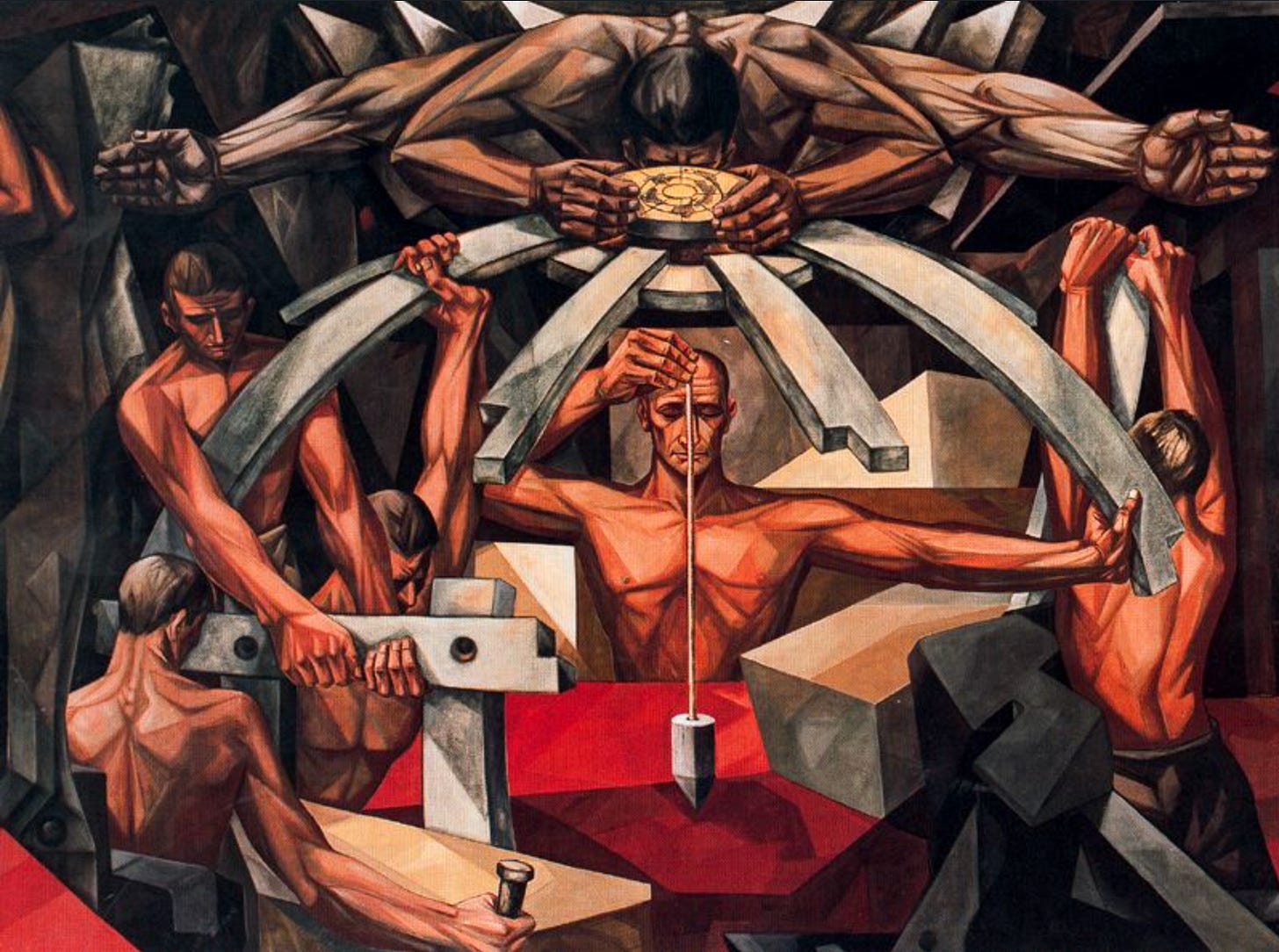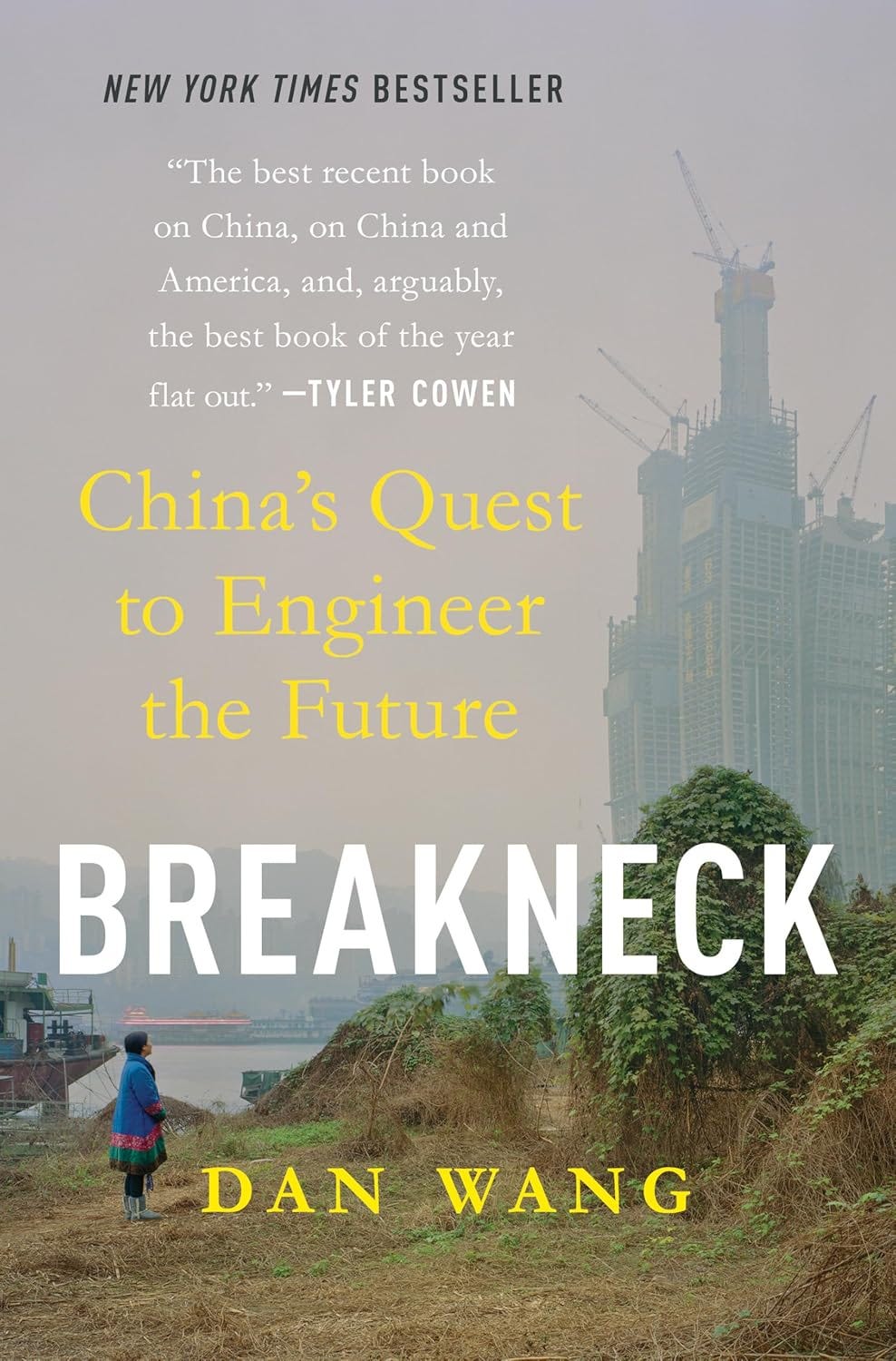Dan Wang's "Breakneck": A Lesson in Disavowed Hawkishness
Like Klein and Thompson's Abundance, Dan Wang wants the U.S. to build. But Breakneck isn't about raising living standards—it's about preparing for war.
Dan Wang, Breakneck: China’s Quest to Engineer the Future (New York: W. W. Norton, 2025).
Dan Wang’s Breakneck can be read as the center-right counterpart to Ezra Klein and Derek Thompson’s center-left Abundance. Where Klein and Thompson largely focused on California to make the case for an American “liberalism that builds”—a greener capitalism aiming to deliver higher living standards—Wang pivots to China to make the case for U.S. manufacturing renewal, now from a less progressive, more security-motivated angle.
Breakneck’s story in a nutshell is that the U.S. has lost the capacity to build; China knows how to build; that’s problematic if the U.S. ever gets into a fight with China; and so it needs to (re)learn how to build.
On the U.S side, at least, this is overstating things. The U.S. still does a lot of manufacturing. In 2022, two-thirds of manufactured goods sold in the U.S. were made there—a ten-percentage-point decline from 2005, but still a substantially high share. There are 13 million manufacturing workers in a sector that exports goods worth $1.6 trillion. Trump’s propaganda would have us believe the U.S. has been almost completely deindustrialized; it hasn’t.
Regardless, like Klein and Thompson, Wang wants to remind his readers of the need to rebuild manufacturing capacity. But unlike Abundance, Wang’s plea for American industrial renewal is framed as part of an ongoing geostrategic contest with China. “If the two superpowers fight in East Asia, it’s not at all clear that the United States will win. America has to build to stave off being overrun commercially or militarily by China.” The end goal in Breakneck isn’t so much higher living standards as military advantage. Where Abundance is a manifesto for a progressive producerism, Breakneck is security nationalism in disguise: building in order to win wars, though framed as part of a new political-economic common sense.
So much for goals. What then of the diagnosis? For all the book’s acclaim, Wang’s causal story is astonishingly reductive: China is a society of engineers while the U.S. is a “lawyerly” society. Wang’s argument, like Klein and Thompson’s before him, has something essentially Musk-like about it: in 2020, Elon Musk lamented that “too many smart people go into finance and law” and claimed that Chinese politicians were better at science. Never mind the counterargument by Foreign Policy’s James Palmer that the Chinese leadership’s engineering training is shallow—more technical certificates than elite degrees. And on the American side, while Clinton, Obama, and Biden went to law school, no Republican president since Ford has. Reagan was an actor; the Bushes and Trump were businessmen. The “lawyerly America” argument doesn’t really explain the divergence.
The political-economic differences between the U.S. and China have less to do with higher education and more to do with ideology. Western countries have been dominated by neoliberalism, which is certainly not laissez-faire but is often uninterested in raising welfare through state action. China, meanwhile, has staked regime survival on great bursts of export-led economic growth and an expansive infrastructure program. Their leaders’ worldviews are rooted in very different orthodoxies. Their divergent track records have little to do with the fact that Clinton went to law school, Ivy League graduates opt for finance and law, or that Xi studied chemical engineering. That Breakneck’s reductive thesis has been met with such praise is surprising—though the FT does acknowledge that “readers might cavil at such sweeping generalisations.” It makes more sense once one realizes how neatly it fits dominant security agendas.
Still, Wang insists that the engineers-versus-lawyers social setup translates into a China that builds and an America that doesn’t. In an interview earlier this year, he said his mission was to remind people that “we live in a material world. Let’s build up a manufacturing base as well.” Given Trump’s rhetoric of reindustrialization, Wang’s claim carries with it more than a whiff of Trumpism, though he thinks Trump’s dismantling of parts of the federal government should be refocused from firing personnel to cutting back on processes. Ironically, here Breakneck overlaps with Abundance: Klein and Thompson, too, think America’s potential has been stifled by legalism.
Wang is far from alone in being concerned with industrial policy; in many ways, it is the major policy concern of our times. And it’s hardly a right-wing issue. The Biden administration ran an aggressively expansionist industrial policy—though Wang thinks, typically, and with thin evidence, that the Biden administration was ineffectual. A convergence of factors has prompted this shift: the trauma of Trump 1.0, the COVID-19 pandemic, Russia’s criminal war of aggression against Ukraine, accelerating climate change, and China’s rise—all these have aligned to nudge the West out of its neoliberal equilibrium. Economic sovereignty is back on the policy agenda on both sides of the Atlantic—often with nationalistic, neomercantilist characteristics—across the political spectrum.
And yet, Wang’s plea for American capacity-building lands on the right flank of this policy conversation. The author’s ideological coordinates seem clear enough: a cover blurb by libertarian economist Tyler Cowen; a fellowship with the conservative Hoover Institution; a concern to uphold “American interests”; and an emphasis on manufacturing as a means to geopolitical supremacy, not collective welfare.
Despite this broadly right-coded approach, Breakneck is in many ways deftly diagonal, slicing across the political spectrum in unexpected ways. Wang is fair in his criticisms of Xi’s China in a way that is noticeably more measured than standard hawkish rhetoric. He skewers the Chinese government’s overreach—from zero-Covid lockdowns in Shanghai to heavy-handed one-child policy measures. And Wang is rightly worried that authoritarian, illiberal modes of governance stifle creativity, innovation, and general well-being. Finally, counterintuitively for a Hoover fellow, Wang argues that the CCP is “Communist” in name only—instead, Xi runs on what in the West would be considered by many a right-wing agenda:
The greatest trick that the Communist Party ever pulled off is masquerading as leftist. While Xi Jinping and the rest of the Politburo mouth Marxist pieties, the state is enacting a right-wing agenda that Western conservatives would salivate over: administering limited welfare, erecting enormous barriers to immigration, and enforcing traditional gender roles.
This argument can be taken too far; as Kevin Rudd has pointed out, Marxism remains an important part of Xi’s economic policy framework—along with Leninism and nationalism.
But despite a generally fair account of China’s problems and pathologies, Breakneck is, at heart, a book about potential military conflict—even as it purports to be a book about political-economic and, to some degree, cultural differences. Wang warns of the possibility of a hot conflict between China and the United States. “A lot of manufacturing and food capacity is a useful thing to have,” Wang writes of Xi’s agricultural policy, “if there is another pandemic—or a war.”
Wang is, of course, right that the U.S.-China relationship is a high-stakes issue that should interest the entire world: “A paramount question of our times is whether hostility between China and the United States can stay at a manageable simmer.” A military conflict between the world’s first and second economic superpowers would be a dire event with global consequences; the two powers would “devastate not only each other but also the world.” Discussing U.S.-China political economy is, therefore, not an intellectual exercise.
What makes this book unique is its disavowed hawkishness with diagonal characteristics. This is not some bellicose work of China-bashing: its criticisms are often sharp and justified. Moreover, it wears its militarism lightly: its policy implications seem, by the end, natural, preparing readers for confrontation while sounding bipartisan: “The two superpowers are uneasily circling each other, reorienting their economies and national security apparatuses to prepare for conflict.”
And yet Wang ignores the fact that the U.S. has spent $4.4 trillion on defense between 2020 and 2024 alone. Under Trump 2.0, the Pentagon’s budget will have risen to about $1 trillion a year. That kind of money gets a lot of engineering done, lawyers notwithstanding. (Wang acknowledges the trillion-dollar budget but claims, without much elaboration, that the “military-industrial complex looks challenged.”) Wang’s worries about American decline overlook the fact that the U.S. remains—and will remain for the foreseeable future—the world’s leading military superpower. Downplaying American military power and production, especially defense production, seems odd—redolent of Pete Hegseth’s sermonizing about the need to create a “warrior ethos,” as if a trillion-dollar fighting force meant nothing.
Its disavowals allow Breakneck to function all the more effectively to advocate for the United States to “build,” not with the essentially civilian purpose of raising living standards—Klein and Thompson’s liberal-centrist aim—but to bolster geopolitical power. In this respect, Wang’s work merges, in multiple ways, with the Trump 2.0 agenda, though without the author having to acknowledge as much. Wang instead gets to play the role of the coolly analytic moderate, not quite concealing the security story but not making it the book’s centerpiece either.
So what would an Abundance–Breakneck part-alternative, part-synthesis look like? Abundance doesn’t go far enough in its progressivism, but at least it keeps societal well-being in focus. Against Breakneck’s narrow nationalism and securitized tenor, collective welfare and mutually beneficial development should be centered. That will be difficult given the nature of the regimes currently involved—on both sides. But simply adding more production power to a state with a trillion-dollar military is not in itself a pathway to stability.








Interesting perspective. I think much of the praise for Breakneck comes from China-watchers and people looking at the book from the perspective of what it says about China. After all, the book is mostly about China's political economy, not the US, even though he also has a point to make about America.
As you say yourself, Breakneck manages to be very fair and accurate in how it talks about China, a rarity among all the books presenting China as either a totalitarian monster or a wonderful place and a great example for the world.